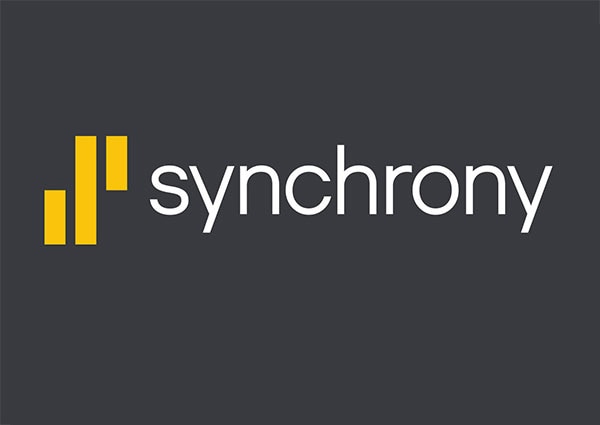Press Release
October 20, 2020, 6:32 AM EDT
Synchrony Reports Third Quarter Net Earnings of $313 Million or $0.52 Per Diluted Share
Included Restructuring Charge of $89 million, or $0.11 Per Diluted Share, and Provision for Credit Losses Included CECL Impact of $66 Million, or $0.09 Per Diluted Share
STAMFORD, Conn. – Synchrony Financial (NYSE: SYF) today announced third quarter 2020 earnings results amid the continuing Coronavirus (COVID-19) pandemic. Synchrony reported third quarter 2020 net earnings of $313 million, or $0.52 per diluted share; this included a restructuring charge of $89 million, or $67 million after tax, which equates to an EPS reduction of $0.11, and an increase in the provision for credit losses as a result of CECL implementation earlier this year of $66 million, or $50 million after tax, which equates to an EPS reduction of $0.09.
Results included*:
- Loan receivables decreased 6% to $78.5 billion, or 5% on a Core** basis
- Interest and fees on loans decreased 22% to $3.8 billion, or 12% on a Core basis
- Purchase volume decreased 6% to $36.0 billion, or flat on a Core basis
- Average active accounts decreased 16% to 64.3 million, or 8% on a Core basis
- Deposits decreased $2.5 billion, or 4%, to $63.5 billion
- Renewed and extended a key relationship with Sam's Club
- Successfully launched the new Venmo program
- Added and extended Payment Solutions relationships with 4 Wheel Parts, Kane’s Furniture, Levin Furniture and Mattress, SVP Sewing Brands LLC, and System Pavers
- CareCredit successfully launched healthcare system partnerships with Lehigh Valley Health Network, St. Luke's University Health Network, and Cox Health and added and extended relationships with Blue River Pet Care and NVA
- Returned $129 million in capital through common stock dividends
“During times of crisis and uncertainty, it is imperative to lead with the fundamental values and principles upon which an organization is built. At Synchrony, we continue to put our employees, partners, customers, shareholders and communities at the forefront of our decision making. Moving in an agile fashion, we quickly reallocated our resources to focus on the most critical priorities to sustain and drive business growth,” said Margaret Keane, Chief Executive Officer, Synchrony Financial.
“In the third quarter, we successfully launched an innovative, digital-first program with Venmo, renewed and extended our relationship with Sam's Club, while also extending several programs and adding new partnerships. We've also deployed an array of enhanced digital solutions for our partners and cardholders, further strengthening our market position and meeting the evolving demands of the new environment,” she added.
Business and Financial Results for the Third Quarter of 2020*
Earnings
- Net interest income decreased $932 million, or 21%, to $3.5 billion, mainly due to the impact of COVID-19 and the Walmart consumer portfolio sale.
- Retailer share arrangements decreased $117 million, or 12%, to $899 million, reflecting the impact ofCOVID-19 on program performance.
- Provision for credit losses increased $191 million, or 19%, to $1.2 billion, mainly driven by the reserve increase for the projected impact of COVID-19 related losses and the prior year reserve reduction related to Walmart, partially offset by lower net charge-offs.
- Other income increased $46 million, or 54%, to $131 million, largely driven by lower loyalty program costs which included the effects of the sale of the Walmart consumer portfolio.
- Other expense was flat; the restructuring charge and expenses related to the COVID-19 response were offset by cost reductions from Walmart, lower purchase volume and accounts, and reductions in certain discretionary spend.
- Net earnings totaled $313 million compared to $1.1 billion last year.
Balance Sheet
- Period-end loan receivables decreased 6%, or 5% on a Core basis; purchase volume decreased 6%, or flat on a Core basis; and average active accounts decreased 16%, or 8% on a Core basis.
- Deposits decreased $2.5 billion, or 4%, to $63.5 billion and comprised 80% of funding.
- The Company’s balance sheet remained strong with total liquidity (liquid assets and undrawn credit facilities) of $26.8 billion, or 28.0% of total assets.
- The Company has elected to defer the regulatory capital effects of CECL for two years; the estimated Common Equity Tier 1 ratio was 15.8% compared to 14.5%, and the estimated Tier 1 Capital ratio was 16.7% compared to 14.5%, reflecting the Company’s strong capital generation capabilities. The estimated Tier 1 Capital ratio also reflects the $750 million preferred stock issuance in November 2019.
Key Financial Metrics
- Return on assets was 1.3% and return on equity was 10.3%.
- Net interest margin was 13.80%.
- Efficiency ratio was 39.7%.
Credit Quality
- Loans 30+ days past due as a percentage of total period-end loan receivables were 2.67% compared to 4.47% last year; excluding the Walmart consumer portfolio, the rate was down approximately 175 basis points compared to last year.
- Through September 30th, we had granted minimum payment forbearance to a cumulative total of approximately 2 million accounts, or $3.8 billion in account balances at the time of forbearance. As of September 30th, only 119,000 accounts or $227 million in account balances remained in forbearance.
- Net charge-offs as a percentage of total average loan receivables were 4.42% compared to 5.35% last year; excluding the Walmart consumer portfolio, the rate decreased approximately 45 basis points compared to last year.
- The allowance for credit losses as a percentage of total period-end loan receivables was 12.92%.
Sales Platforms
- Retail Card period-end loan receivables decreased 6%, driven primarily by the impact from COVID-19, partially offset by growth in digital partners. Interest and fees on loans decreased 27%, purchase volume decreased 7%, and average active accounts decreased 19%, driven primarily by the sale of the Walmart consumer portfolio and the decline in loan receivables.
- Payment Solutions period-end loan receivables decreased 5%; period-end loan receivables decreased 1% on a Core basis primarily due to the impact from COVID-19, partially offset by growth in Power. Interest and fees on loans decreased 10%, driven primarily by lower late fees. Purchase volume decreased 6% and average active accounts decreased 7%.
- CareCredit period-end loan receivables decreased 7%, driven primarily by the impact from COVID-19. Interest and fees on loans decreased 8%, driven primarily by lower merchant discount as a result of the decline in purchase volume, which decreased 3%. Average active accounts decreased 8%.
* All comparisons are for the third quarter of 2020 compared to the third quarter of 2019, unless otherwise noted.
** Financial measures shown above on a Core basis are non-GAAP measures and exclude from both the prior year and the current year amounts related to the Walmart and Yamaha portfolios, sold in October 2019 and January 2020, respectively. See non-GAAP reconciliation in the financial tables.
Corresponding Financial Tables and Information
No representation is made that the information in this news release is complete. Investors are encouraged to review the foregoing summary and discussion of Synchrony Financial's earnings and financial condition in conjunction with the detailed financial tables and information that follow and the Company’s Annual Report on Form 10-K for the fiscal year ended December 31, 2019, as filed February 13, 2020, and the Company’s forthcoming Quarterly Report on Form 10-Q for the quarter ended September 30, 2020. The detailed financial tables and other information are also available on the Investor Relations page of the Company’s website at www.investors.synchronyfinancial.com. This information is also furnished in a Current Report on Form 8-K filed with the SEC today.
Conference Call and Webcast Information
On Tuesday, October 20, 2020, at 8:30 a.m. Eastern Time, Margaret Keane, Chief Executive Officer, Brian Doubles, President, and Brian Wenzel Sr., Executive Vice President and Chief Financial Officer, will host a conference call to review the financial results and outlook for certain business drivers. The conference call can be accessed via an audio webcast through the Investor Relations page on the Synchrony Financial corporate website, www.investors.synchronyfinancial.com, under Events and Presentations. A replay will also be available on the website.
About Synchrony Financial
Synchrony (NYSE: SYF) is a premier consumer financial services company. We deliver a wide range of specialized financing programs, as well as innovative consumer banking products, across key industries including digital, retail, home, auto, travel, health and pet. Synchrony enables our partners to grow sales and loyalty with consumers. We are one of the largest issuers of private label credit cards in the United States; we also offer co-branded products, installment loans and consumer financing products for small- and medium-sized businesses, as well as healthcare providers.
Synchrony is changing what’s possible through our digital capabilities, deep industry expertise, actionable data insights, frictionless customer experience and customized financing solutions.
For more information, visit www.synchrony.com and Twitter: @Synchrony.
Cautionary Statement Regarding Forward-Looking Statements
This news release contains certain forward-looking statements as defined in Section 27A of the Securities Act of 1933, as amended, and Section 21E of the Securities Exchange Act of 1934, as amended, which are subject to the "safe harbor" created by those sections. Forward-looking statements may be identified by words such as "expects," "intends," "anticipates," "plans," "believes," "seeks," "targets," "outlook," "estimates," "will," "should," "may" or words of similar meaning, but these words are not the exclusive means of identifying forward-looking statements. Forward-looking statements are based on management's current expectations and assumptions, and are subject to inherent uncertainties, risks and changes in circumstances that are difficult to predict. As a result, actual results could differ materially from those indicated in these forward-looking statements. Factors that could cause actual results to differ materially include global political, economic, business, competitive, market, regulatory and other factors and risks, such as: the impact of macroeconomic conditions and whether industry trends we have identified develop as anticipated, including the future impacts of the novel coronavirus disease (“COVID-19”) outbreak and measures taken in response thereto for which future developments are highly uncertain and difficult to predict; retaining existing partners and attracting new partners, concentration of our revenue in a small number of Retail Card partners, and promotion and support of our products by our partners; cyber-attacks or other security breaches; disruptions in the operations of our computer systems and data centers; the financial performance of our partners; the sufficiency of our allowance for credit losses and the accuracy of the assumptions or estimates used in preparing our financial statements, including those related to the new CECL accounting guidance; higher borrowing costs and adverse financial market conditions impacting our funding and liquidity, and any reduction in our credit ratings; our ability to grow our deposits in the future; damage to our reputation; our ability to securitize our loan receivables, occurrence of an early amortization of our securitization facilities, loss of the right to service or subservice our securitized loan receivables, and lower payment rates on our securitized loan receivables; changes in market interest rates and the impact of any margin compression; effectiveness of our risk management processes and procedures, reliance on models which may be inaccurate or misinterpreted, our ability to manage our credit risk; our ability to offset increases in our costs in retailer share arrangements; competition in the consumer finance industry; our concentration in the U.S. consumer credit market; our ability to successfully develop and commercialize new or enhanced products and services; our ability to realize the value of acquisitions and strategic investments; reductions in interchange fees; fraudulent activity; failure of third parties to provide various services that are important to our operations; international risks and compliance and regulatory risks and costs associated with international operations; alleged infringement of intellectual property rights of others and our ability to protect our intellectual property; litigation and regulatory actions; our ability to attract, retain and motivate key officers and employees; tax legislation initiatives or challenges to our tax positions and/or interpretations, and state sales tax rules and regulations; a material indemnification obligation to GE under the Tax Sharing and Separation Agreement with GE if we cause the split-off from GE or certain preliminary transactions to fail to qualify for tax-free treatment or in the case of certain significant transfers of our stock following the split-off; regulation, supervision, examination and enforcement of our business by governmental authorities, the impact of the Dodd-Frank Wall Street Reform and Consumer Protection Act and other legislative and regulatory developments and the impact of the Consumer Financial Protection Bureau’s regulation of our business; impact of capital adequacy rules and liquidity requirements; restrictions that limit our ability to pay dividends and repurchase our common stock, and restrictions that limit the Synchrony Bank’s ability to pay dividends to us; regulations relating to privacy, information security and data protection; use of third-party vendors and ongoing third-party business relationships; and failure to comply with anti-money laundering and anti-terrorism financing laws.
For the reasons described above, we caution you against relying on any forward-looking statements, which should also be read in conjunction with the other cautionary statements that are included elsewhere in this news release and in our public filings, including under the heading "Risk Factors" in the Company's Annual Report on Form 10-K for the fiscal year ended December 31, 2019, as filed on February 13, 2020, and the Company’s Quarterly Report on Form 10-Q for the quarter ended June 30, 2020, as filed on July 23, 2020. You should not consider any list of such factors to be an exhaustive statement of all the risks, uncertainties, or potentially inaccurate assumptions that could cause our current expectations or beliefs to change. Further, any forward-looking statement speaks only as of the date on which it is made, and we undertake no obligation to update or revise any forward-looking statement to reflect events or circumstances after the date on which the statement is made or to reflect the occurrence of unanticipated events, except as otherwise may be required by law.
Non-GAAP Measures
The information provided herein includes measures we refer to as "tangible common equity" and certain “Core” financial measures that have been adjusted to exclude amounts related to the Walmart and Yamaha portfolios, sold in October 2019 and January 2020, respectively, which are not prepared in accordance with U.S. generally accepted accounting principles ("GAAP"). For a reconciliation of these non-GAAP measures to the most directly comparable GAAP measures, please see the detailed financial tables and information that follow. For a statement regarding the usefulness of these measures to investors, please see the Company's Current Report on Form 8-K filed with the SEC today.
Contacts:
Investor Relations:
Greg Ketron
(203) 585-6291
Media Relations:
Sue Bishop
(203) 585-2802











